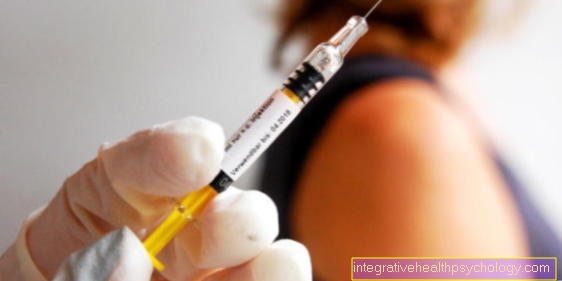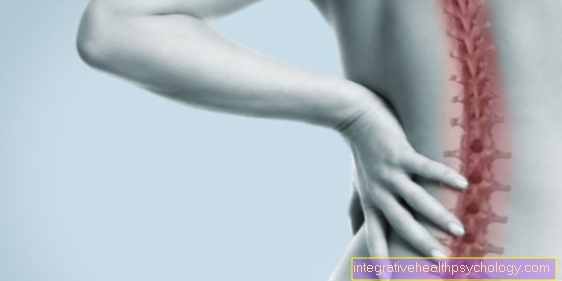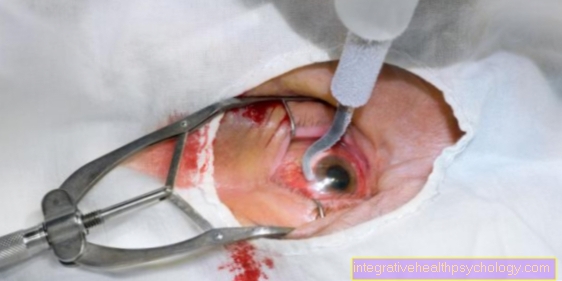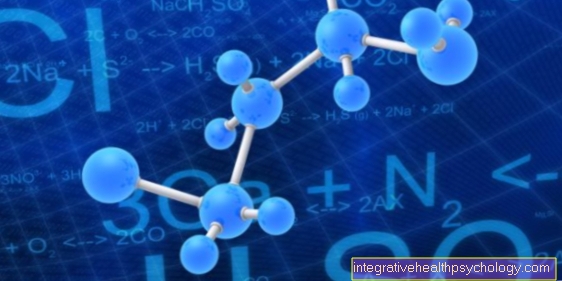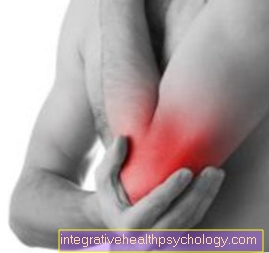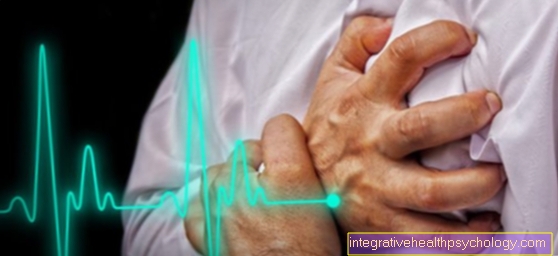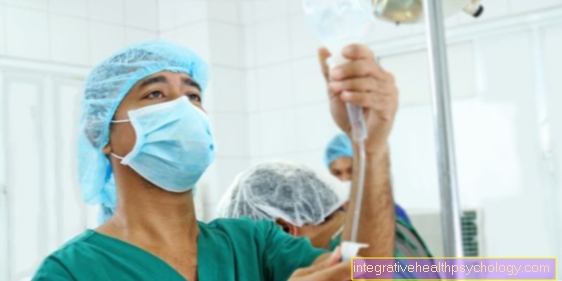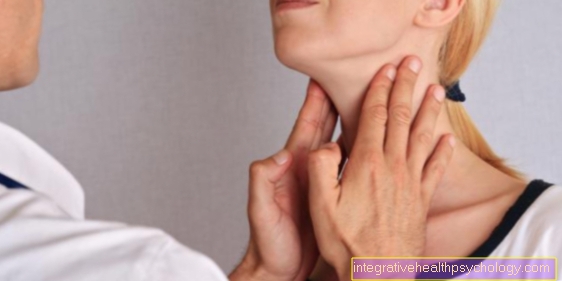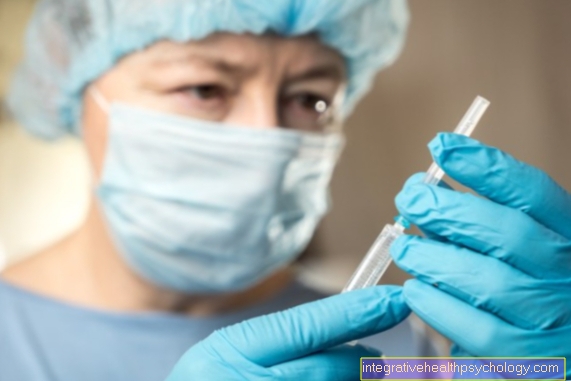CRPS (Complex Regional Pain Syndrome)
.jpg)
definition
The abbreviation CRPS stands for “Complex Regional Pain Syndrome”, translated means “complex regional pain syndrome”. This disease is also known under the name Sudeck's disease (named after its discoverer Paul Sudeck), algo- or (sympathetic) reflex dystrophy. CRPS occurs particularly often on the limbs, usually on the arms or hands. Women are affected slightly more often than men.
CRPS is a chronic neurological disease that is characterized by initially severe local pain and later a decrease (atrophy) of muscle tissue in the affected limb.
root cause
How it comes to the clinical picture of CRPS has not yet been conclusively clarified. The most common triggers are injuries, for example a fracture of the forearm (radius fracture). However, inflammation or surgery can also be the cause of CRPS. Sometimes the causal injury is so minor that the victim cannot remember it. The extent of the pain syndrome is not directly related to the extent of the injury.
In CRPS, tissue healing is impaired after the injury. It is thought to be related to an inflammatory response.
There is probably an overproduction of inflammatory mediators that are not broken down quickly enough by the body. This prolongs the inflammation and sensitizes the nerves that are responsible for feeling pain. Various processes in the brain and spinal cord lead to an increased perception of pain.
Types
There are two different types (types) of CRPS.
Type I: Type I of CRPS was formerly known as Sudeck's disease. In this case, the typical clinical symptoms and complaints occur without any obvious damage to the nerves. Approx. 90% of all CRPS cases are of type I.
Type II: In type II there is demonstrable damage to nerves in the injured body region due to a fracture or trauma to a limb. Since there is a cause that is related to the symptoms that occur, type II is also referred to as causal type (causalgia). The symptoms can spread beyond the actual supply area of the affected nerves.
Appointment with a hand specialist?_2.jpg)
I would be happy to advise you!
Who am I?
My name is dr. Nicolas Gumpert. I am a specialist in orthopedics and the founder of .
Various television programs and print media report regularly about my work. On HR television you can see me every 6 weeks live on "Hallo Hessen".
But now enough is indicated ;-)
In order to be able to treat successfully in orthopedics, a thorough examination, diagnosis and a medical history are required.
In our very economic world in particular, there is too little time to thoroughly grasp the complex diseases of orthopedics and thus initiate targeted treatment.
I don't want to join the ranks of "quick knife pullers".
The aim of any treatment is treatment without surgery.
Which therapy achieves the best results in the long term can only be determined after looking at all of the information (Examination, X-ray, ultrasound, MRI, etc.) be assessed.
You can find me at:
- Lumedis - orthopedics
Kaiserstrasse 14
60311 Frankfurt am Main
Directly to the online appointment arrangement
Unfortunately, appointments can only be made with private health insurers. I ask for understanding!
Further information about myself can be found at Lumedis - Dr. Nicolas Gumpert
Stages
The disease can be divided into different stages, which describe the rough course of the disease. However, a strict demarcation is difficult in everyday life, as there is often overlap. Overall, the course of the disease differs greatly from person to person.
Stage I: Stage I is also known as the inflammatory stage. Strong, burning pain occurs at rest as well as inflammatory swellings in the affected area. In addition, there is increased blood circulation, changes in skin color and temperature, and hypersensitivity to touch. Increased sweating and water retention can also be observed at this stage. This stage lasts up to 3 months.
Stage II: Characteristics of stage II are spreading, increasing or decreasing pain, incipient stiffening of the joints and osteoporosis (decalcification and susceptibility to fracture of bones). There is also a decrease in muscle mass (muscle atrophy) and changes in the skin and nails (e.g. cold, pale skin).
Stage III: In stage III the pain is no longer limited to one area, but rather diffuse. In some patients they may even have disappeared completely. Typical signs are restricted mobility and loss of function of the affected extremity (arms or legs), significant muscle and tissue loss, and thin, shiny skin. Due to the increasing decrease in mobility and function, this stage is also known as the atrophic, degrading stage.
Symptoms
_3.jpg)
In CRPS, the focus is on pain, which is usually described as burning. Sensitivity to touch in the affected area is also typical. Various other complaints can arise over time.
Initially, the disease is characterized by inflammation. In addition to pain, this also results in water retention and circulatory disorders. These lead to swelling, muscle cramps and a bluish-purple discoloration of the skin. In addition, increased sweating and restricted mobility can occur. Some people then heal spontaneously, while others tend to feel worse.
If there is no healing, the pain usually spreads further, the water retention hardens and growth disorders of the skin and nails can occur. There is also the loss of muscle and bone tissue and increasing restriction of movement.
Approx. 6 months after the symptoms began, the last phase of the disease can occur. Here the tissue shrinkage increases and is no longer reversible. The water retention and pain continue to spread. The skin and bones thin out and the limb can become dysfunctional. In rare cases, blood pressure fluctuations and a disturbance of the immune system can also occur.
diagnosis
The diagnosis of CRPS is relatively complicated because there is no simple test procedure, the causes are still largely unknown and it can develop very differently in different patients.
Therefore, the diagnosis is usually based on the patient's medical history and symptoms. In addition, procedures such as magnetic resonance imaging (MRI) and x-rays to assess joints and soft tissue, or a measurement of the skin temperature can be considered.
therapy
The treatment of this pain syndrome is also not easy, usually very tedious and not even then promising in all cases.
The earlier the disease is recognized and therapy started, the better the patient's chances of becoming symptom-free again. A chronification, i.e. Fortunately, a persistent disease rarely develops. It is important to include different approaches in the therapy.
The focus is of course on pain therapy. This is where anti-inflammatory pain medication such as ibuprofen or diclofenac are used. Cortisone or antidepressants can also be used. These help particularly well with pain that comes from the nerves themselves. In addition, ointments such as dimethyl sulfoxide ointment can be used as a support. This has an anti-inflammatory and analgesic effect and is said to have a beneficial effect on water retention.
While immobilization and elevation of the affected limb is more helpful in the acute stage, subsequent physiotherapeutic treatment is very important to prevent functional restrictions in the affected area.The subsequent muscle rebuilding is also very important to ensure the stability and mobility of a joint. This can also be supported and instructed by physiotherapy.
Vitamin D and calcium supplements can also be used to protect the bones.
Certainly not to be underestimated is the psychological care of those affected, as depression, fears, and reduced self-esteem can often play a role in the chronification of the disease. This also includes behavioral therapies and relaxation therapies.
Occupational therapy
The aim of occupational therapy is to make everyday life easier for the patient, so the quality of life is extremely increased. Various exercises and aids are used here.
Active movement therapy is an important method of occupational therapy. Active movement of the muscles promotes and maintains the function of muscles, tendons and ligaments. It is important to maintain the normal degree of movement and to prevent incorrect posture and thus tension and damage to the musculoskeletal system. This in turn facilitates independence in everyday life.
Another point is learning movement sequences and methods that make everyday tasks easier. The correct handling of aids such as grip thickened handles, shoe spoons and the like is also practiced here. With limited mobility and lack of strength, everyday things such as tying shoes or opening bottles can be difficult. Occupational therapy helps the patient to cope better with such everyday tasks.
Sometimes dynamic splints can also be used to relieve a joint, which allow mobilization earlier.
Hot or cold applications are not suitable for treating CRPS.
Nerve block and stimulation
A nerve block can help relieve pain, especially if you have CRPS on your hand or arm. These procedures are used when other measures, such as medication and physical therapy, have failed to provide pain relief.
There is the possibility of an opioid, a very strong pain reliever, being injected into the immediate vicinity of a nerve or a collection of nerve cells, a so-called ganglion. The ganglia are, so to speak, switching stations for the conduction of pain. This interrupts the transmission of the pain.
There is also the option of using this method to "switch off" the nerve plexus responsible for the arm, the so-called brachial plexus, or individual nerves.
Another way to reduce pain is through nerve stimulation. This can be done either through the skin or on the spinal cord. Electrodes are used to set a current stimulus to prevent the pain information from being passed on to the brain via the nerves.
When stimulating the spinal cord, electrodes are placed through a small incision on the meninges of the spinal cord, where they apply light electrical impulses. The electrodes can remain there for several years.
With skin nerve stimulation (transcutaneous nerve stimulation), the electrodes are placed on the skin of the painful area. On the one hand, various electrical impulses release endorphins, which contribute to pain relief, on the other hand, pain-conducting nerves are blocked.
Lymphatic drainage
With Lymphatic drainage one prevents unpleasant ones Swelling. Lymph drainage is about distributing the accumulated lymph fluid in the lymph vessels in order to improve lymph drainage. Through various special grip techniques that are similar to a massage look, the pumping system of the lymph is stimulated. Because due to the different pressure on the Lymphatic vessels the tissue is irritated and the muscle cells of the lymphatic vessels are stimulated to contract and increase the pumping frequency. The movement of the Lymphatic drainage towards the efferent large lymphatic vessels and lymphatic trunks. In addition to the effect of lymph drainage-promoting effect Lymph drainage also has a pain-relieving, calming, stimulating effect on the gastrointestinal tract and reducing the tone of the body Skeletal muscles.
Duration of a CRPS
The duration of CRPS depends on the type of disease and its severity. In general, it can be said that most patients are able to control the pain that occurs after successful therapy, whereby slight limitations in mobility and function of the affected body part may remain. The earlier the disease is recognized and the earlier treatment begins, the more favorable the healing prognosis. The combination of painkillers, physical and occupational therapy as well as psychological treatment plays a central role. With their help, pathological, painful movement patterns should be reduced and normal sensitivity restored. In a very small proportion of patients, however, the disease can take a chronic course. The persistent, non-regressive pain persists for a lifetime and there is also a permanent loss of function of the affected limbs. These patients require intensive therapy throughout their life.
CRPS hand
_4.jpg)
The CRPS (complex regional pain syndrome) at the top extremity often arises from Fractures. This can lead to both surgical and conservative care CRPS disease come.
Upper limb CRPS is the most common contributor Radius fractures a role. Here the CRPS occurs in 1-2% of the cases. The disease can also occur in minor trauma.
Generally the upper extremity 4 times more often affected by CRPS disease. It is also often the case that the severity of the injury does not correlate with the degree of CRPS. As a rule, however, CRPS triggered by fractures have a good prognosis.
As Occupational diseases at the upper extremity the disease often occurs in knitters, shorthand typists (shorthand typists are typewriters) and compressed air workers. Here it comes to Incorrect or overloading of the jointswhich can lead to an outbreak of CRPS.
course
in the Stage of inflammation the hand is swollen and doughy and discolored blue-red. Also kick Pain on, which also increases the mobility of the Joints is affected.
In the next stage of the Dystrophy, a so-called incorrect growth, there is a significant muscle wasting with bone loss. The skin is now pale and does not have enough blood.
In the last stage there is absolute tissue loss. It can stiffen the Joints come in the region.
Complications
This represents a complication of the CRPS of the hand Hand shoulder syndrome because the disease can spread to shoulder spread.
Under the Hand shoulder syndrome one understands a painful degenerative change with restricted mobility in the area of the Shoulder girdle (also called humeroscapular periarthritis) in combination with the CRPS syndrome in this area. There is also a Stiffening of the jointsthereby worsening the restriction of movement. The classic CRPS symptoms also occur. In addition, the disease can affect the finger expand and also lead to a stiffening of the joints.
Further complications are disabilities caused by the CRPS disease, which are particularly affected by the hand and can seriously affect the everyday life of those affected.
therapy
_5.jpg)
For the therapy of CRPS on the hand, the same treatment methods are generally used as for CRPS in general.
The treatment includes pain therapy, physiotherapy and occupational therapy and supportive psychotherapy.
If these measures are unsuccessful, methods such as nerve blocks or nerve stimulation are used. These can be used particularly well on the hand.
CRPS foot
_6.jpg)
That too CRPS of the foot is often triggered by trauma or operations. Even minor trauma can trigger the syndrome. The disease can also be here in different degrees occur. Some patients complain that they can no longer occur because of the pain or because of the swelling not being able to put the shoes on properly anymore. This fits in with the first stage, the Stage of inflammation. The pain can become so severe that any touch is painful, making it difficult for patients to put on socks or pants, as the pain is so unbearable even here. In the next stages there will be one here too muscular dystrophy and Bone loss. In the further course it can lead to Stiffening of the joints come.
therapy
First of all, all possible conservative measures should be used before invasive measures are considered. The forms of therapy do not differ that much from the treatment options on the hand. Here too you can Painkiller take and physical therapy, Occupational therapy and use aqua aerobics to reduce pain. You should also use the psychological Don't forget to take care of the patient.
If conservative measures fail, invasive measures are used.
Nerve block
With nerve blocks in the lower limbs, people like to block the sciatic nerve. A distinction is made here between a blockage close to the trunk (proximal) and a remote (distal) blockage.
With the trunk blockade, the nerve is blocked as soon as it leaves the pelvis. The entire nerve plexus of the lower limb can also be numbed. This makes the entire leg pain-free.
In the case of a blockade away from the trunk, only the nerve in the hollow of the knee is numbed. This only affects the pain sensation in the lower leg and foot.
Proximal blockage
Here the nerve after leaving the pool blocked. There are various access routes that can be used. In doing so, one usually blocks not just one nerve but the entire nerve network of the lower limb, the so-called Lumbar plexus. This becomes the complete leg made painless. You can also block other nerves depending on the access route. The blockage is easier when you have one Ultrasound machine has on hand or uses a current stimulator for precise localization.

